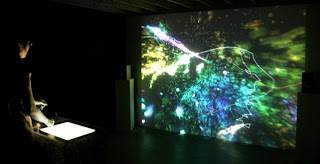 ARTIFICAL NATURE:
ARTIFICAL NATURE:While researching ideas on our project I managed to stumble upon a very interesting concept in development at the moment. Artificial Nature is a transdisciplinary research project of creativity in complex systems that investigate environment generation through the computational generative ecosystems. Its whole purpose is to explore creativity as a form of art, study and play, by taking inspiration from nature's creativity but recognizing the potential of natural creation more than just the physical aspects. Spectators can witness, control and manufacture amazing, complex and intuitive patterns evolving from the behaviors of the species, as the organisms in turn interact with their dynamic environment. It uses unfamiliar data and uses it to create art in a way that has never before been used. And it is all inspired by the combination of art and animation. Furthermore, it is simply a tool that provides the means to create art using the imagination. I thought this was very relevant to my project because it absorbed data to recreate a piece of ever changing artwork. I can relate to this because my project will do exactly the same thing. We are hoping to use flex sensors in order to record the texture of our surroundings and use that information to generate a new perspective on the environment. Artificial nature allows viewers to view nature from the microorganism level and gives insight as to how complex nature truly is. It goes far beyond just ‘animals.’ People fail to consider where it all originated from on a cellular level. This to me is a great way of allowing people to view a different perspective of the wilderness in an evolving 3d environment. This relates to my project because we too are showing the city from a different perspective in the sense that most people view it as a static object as a whole. People fail to see its true fragility and how it came to be.
3D PROJECTION:
Another example I found of experimental technology that relates to my project was 3D projection. I thought it was a great source of information and explores the use of texture very well. It dissolves and breaks through the restraints that architecture has set in our modern world. The structure of buildings restricts its artistic value. However with 3D projection, the boundaries are limitless. It allows the structure to adopt any kind of texture that it wishes. Perhaps in the future we will see buildings, pristine and smooth, void of architecture, and instead its design will be solely based on projectors. It relates to my project because we ourselves are exploring a similar concept of texture. As above, I believe our texture recording concept is showing us the outdated surfaces that surround us every day within the CBD. We see cracks, and flaws everywhere we look. It gives the city a ‘grungy’ feel to it to see these features. Buildings are simply a solid façade. 3D projectors allow us to uncover different interpretations of conception, geometry and aesthetics expressed through graphics and movement.
PETER CAMPUS
While researching I also fell upon a contemporary artist called Peter Campus. He was not any other art I had seen before. He was able to explore the world beyond its face value in 3D video like never before. His works are old but I feel they need to be mentioned because they are still relevant to this day and also have a great importance to our current project which is being developed. The most striking video that I watched was one called 'Three Transistions.' In this video Peter explored surfaces beyond their face value. He cuts through a wall of paper, but as he enters the hole he has cut he also is emerging at the same time (weird i know). He showed that surfaces can be more than their 2D perception. Just like in the city where the walls themselves are an illusion. The walls, from a distance seem to be 2D and flat, where as when you get closer you become aware that nothing is as pristine as it seems at first. Even the smoothest surface has blemishes, and this is the point that I wanted to highlight with our project.
No comments:
Post a Comment